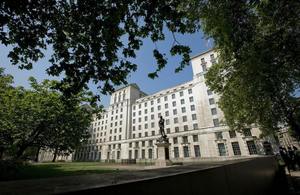HMS Protector cuts through Antarctic ice
The ship arrived in Antarctica for the first time two weeks ago after her long sail south from Portsmouth and is following up important survey…

The ship arrived in Antarctica for the first time two weeks ago after her long sail south from Portsmouth and is following up important survey work for shipping in the region with visits to remote research bases locked in the frozen continent.
At Deception Island, a stunning water-filled volcanic caldera that is one of just two in the world, Protector sent her smaller survey boat James Caird IV with multibeam echo sounder equipment to survey the area known as ‘Neptune’s Bellows’.
It was here that in 2007 the cruise ship MV Nordkapp ran aground and was assisted by the previous ice patrol ship HMS Endurance.
Leading Seaman Chris Smith, the boat’s coxswain, said:
Working on the Neptune’s Bellows survey was a highly satisfying job professionally; being part of a team that worked on something this important to the safety of navigation makes all the hard work of being away from my family worthwhile.
A team of four spent two nights at an abandoned Admiralty base, braving gale-force winds with 55-knot (100km/h) gusts to both collect information used for chart-making and satellite-positioning and to record the tidal range.
The team took precise GPS measurements on land to make sure the tide gauge was level. The information will allow the UK Hydrographic Office in Taunton to produce accurate charts for ships transiting the area.
Lieutenant Graham Blenkinsop, the officer in charge of the survey boat, said:
The opportunity to survey Neptune’s Bellows was fantastic; being able to use the Royal Navy’s most advanced survey motor boat and in such a stunning area.
It was even more satisfying to know that the work we were doing will have a direct impact on the safety of the many cruise ships and research vessels that pass through Neptune’s Bellows and to know that we have done our part to make such an isolated part of the world safer for the ships and their crews.
Later, some of the crew of HMS Protector visited the Spanish Antarctic station Gabriel de Castilla, meeting base commander Major Antonio Casals Abraham and his team, who greeted them with a British Union Flag flying next to the Spanish flag on the beach.
After a tour, Lieutenant Commander Andy Storey, Operations Officer on Protector, presented a ship’s crest to the base commander and invited him to dinner with Captain Peter Sparkes, Protector’s Commanding Officer, and the Commanding Officer of the Spanish Antarctic patrol ship SPS Las Palmas.
It was in the Lemaire Channel that HMS Protector first broke the ice to mark her role as the Royal Navy’s ice patrol ship. It took four hours to travel through the passage, with the ice increasing steadily, and seals and penguins on the ice floes.
Protector then moved on to Port Lockroy, a historic British base manned by the UK Antarctic Heritage Trust. She brought vital stock, loaded in Portsmouth, to resupply the base, as well as its Post Office and small shop.
The ship’s work boat Terra Nova delivered the supplies and then transferred building waste back to Protector to follow Antarctic Treaty and environmental protocols.
The ship’s company visited the museum at Port Lockroy where living conditions from the 1940s and 1950s are preserved with handwritten notes and other memorabilia. Lieutenant Simon Lockley discovered that his namesake Sub-Lieutenant Lockley was one of the first base commanders there 60 years ago.
Meanwhile, for three days, Protector deployed her cold weather experts, the Royal Marines, to complete their cold weather training.
Colour Sergeant Mick Cowe, a Mountain Leader, said:
The environment in Antarctica offers a unique challenge. We are here to provide the appropriate level of expertise to the ship’s company and these few days ashore have helped to consolidate our perishable skill set.
HMS Protector has since recovered scientists from the British Antarctic Survey who were dropped off to investigate global warming. Her patrol continues.